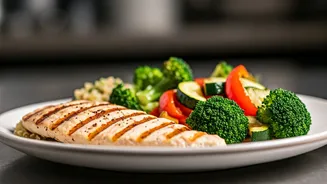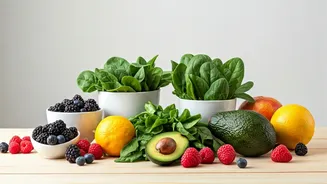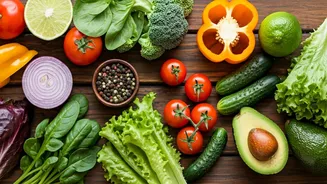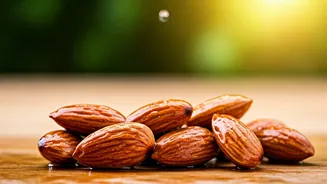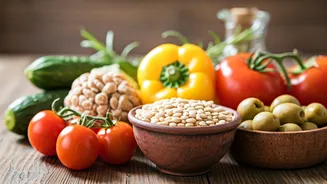Nutrient-Rich Foundation
Building a healthy and delicious meal starts with understanding the basic building blocks of nutrition. A balanced plate should primarily consist of colorful
vegetables and fruits, providing a wealth of vitamins, minerals, and antioxidants. These are crucial for overall well-being. Next, include lean proteins, such as chicken breast, fish, lentils, or tofu, which are vital for repairing and building body tissues. Complex carbohydrates like whole grains (brown rice, quinoa, or oats) provide sustained energy and fiber. Healthy fats from sources like avocados, nuts, and olive oil contribute to brain function and hormone production. The balance of these macronutrients will help you feel satisfied and energized throughout the day, ensuring the body gets the vital fuel it needs.
Flavorful Ingredient Choices
Selecting the right ingredients is key to transforming a healthy meal into a culinary experience. Start by embracing fresh, seasonal produce; they not only taste better but are also richer in nutrients. Experiment with a variety of vegetables and fruits to ensure a diverse intake of vitamins and minerals. Opt for lean protein sources, such as skinless chicken or turkey breast, fish rich in omega-3 fatty acids (salmon or tuna), or plant-based proteins such as beans and lentils. Whole grains, which include brown rice, quinoa, and whole-wheat pasta, provide a slower release of energy and are a good source of fiber. Healthy fats, like avocados, nuts, seeds, and olive oil, contribute to the flavor and nutritional value of your meals. Incorporating these elements will add both flavor and nutritional value to every dish.
Cooking for Maximum Taste
The method of cooking can significantly influence both the taste and nutritional value of your meals. Steaming, grilling, baking, and stir-frying are generally healthier options compared to deep-frying. Steaming preserves the nutrients in vegetables, while grilling adds a smoky flavor without extra fats. Baking is a convenient method for preparing a variety of dishes, from vegetables to lean proteins, and allows for even cooking. Stir-frying requires minimal oil and allows for quick cooking, maintaining the crispness and nutrients in your ingredients. When using oil, opt for healthy options like olive oil, avocado oil, or coconut oil, and use them sparingly. Season your dishes with herbs, spices, lemon juice, or vinegar to enhance flavors without adding excess salt or sugar. Mastering these cooking techniques is key to creating healthy and delicious meals.
Simple Recipe Ideas
Ready to get cooking? Here are a few simple recipes to get you started. For a quick and easy breakfast, try overnight oats: Combine rolled oats, chia seeds, almond milk, and your favorite fruits (berries, banana) in a jar the night before. For lunch, create a vibrant salad with mixed greens, grilled chicken or chickpeas, avocado, and a light vinaigrette. For dinner, try baked salmon with roasted vegetables (broccoli, bell peppers, zucchini); season with herbs and a squeeze of lemon. Another easy dinner option is lentil soup, made with vegetables, lentils, vegetable broth, and spices. These recipes are not only delicious but also easy to customize with your preferred ingredients, making healthy eating fun and personalized. Enjoy the culinary journey and discover the joy of creating meals that are both healthy and delicious.
Portion Control Strategies
Even the healthiest meals can contribute to weight gain if consumed in excessive portions. Being mindful of your portion sizes is crucial for maintaining a balanced diet. Start by using smaller plates and bowls to create the illusion of a larger meal. Measure out your portions, especially when you are preparing grains, proteins, and fats. Pay attention to hunger and fullness cues, and stop eating when you are satisfied, rather than stuffed. Avoid eating directly from the package, as this can lead to overeating. Planning your meals ahead of time can help you control your portions and ensure that you're eating a balanced diet. Pack your lunch instead of eating out, which allows you to control the ingredients and portion sizes. Consider incorporating a variety of foods, and eating slowly to fully appreciate your meal.
Staying Hydrated & Hydrated
Proper hydration is essential for overall health and plays a significant role in weight management and energy levels. Drinking enough water supports bodily functions, including digestion, nutrient absorption, and metabolism. Aim to drink water throughout the day, rather than waiting until you feel thirsty. Carry a reusable water bottle with you to make it easier to stay hydrated. Infuse your water with fruits like lemon, cucumber, or berries to add flavor and encourage you to drink more. Besides water, other healthy hydration sources include herbal teas, unsweetened fruit-infused water, and vegetable juices. Avoid sugary drinks like soda and fruit juices, which can contribute to excess calories and hinder your weight loss efforts. Keeping hydrated helps the body function optimally, and contributes to feeling fuller, which also supports a healthy diet.


